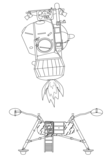LK (spacecraft)
The LK (Lunniy Korabl—"lunar craft") was a Soviet lunar lander and counterpart of the American Lunar Module (LM). The LK was to have landed a single Soviet citizen on the Moon before the Americans, winning the Moon race. It completed development and was test flown successfully in Earth orbit, but never reached the Moon because the N1 rocket required to take it to the Moon was never successful.
Lunniy Korabl compared to Lunar Module
Because the translunar payload capacity of the N1 rocket was only 70% that of the American Saturn V, the LK differed in many ways from the Apollo Lunar Module (LM):
- It had a different landing profile
- It was 1/3 the weight of the LM
- It was limited to a crew of one; the LM carried two
- It had no docking tunnel like the LM's; the cosmonaut had to space walk from the LOK (Soyuz 7K-L3) Command Ship to the LK and back
- To leave lunar orbit and begin descent, the LK used the same braking stage, the Block D, which put the LK-Soyuz stack into lunar orbit; the LM used its landing stage engine (though later Apollo missions also used the SPS engine to help deorbit the LM)
- The final deceleration, from a velocity of 100 m/s at an altitude of 4 km above the lunar surface, was done with a Block E stage, which was later used as the ascent stage to return the LK to lunar orbit; the LM's landing stage had a dedicated engine for landing
- the LK ascended from a landing gear structure which did not have its own means of propulsion; the LM lifted off with a separate ascent engine rather than re-use the landing engine.[1]
Korolev's N1-L3 plan

Korolev's final plan for a manned landing adopted the same method of lunar orbit rendezvous as Project Apollo.
LOK Command Ship—Lunniy Orbitalny Korabl
A variant of the Soyuz, the LOK (Soyuz 7K-L3) Command Ship (Lunniy Orbitalny Korabl), would carry a two-man crew atop a single three-stage N-1 booster.
A fourth stage would push the LOK, the Block D fifth stage, and the LK lander toward the moon. The Block D engine would slow the LOK and LK into lunar orbit.
LK Lander—Lunniy Korabl
Following the coast to the moon, one cosmonaut would spacewalk from the LOK to the LK lander and enter it. He would then separate the Block D stage and the LK from the LOK before dropping toward the moon using the Block D engine.

Lunar landing
After the Block D stage exhausted its fuel, the LK lander would separate, and land using its own engine. As originally planned, an earlier unmanned probe of the Luna programme would act as a beacon for the LK. The lone cosmonaut would collect moon rocks and hoist the Soviet flag.
Earth return
After a day on the lunar surface the LK's engine would fire again, using its landing leg structure as a launch pad. To save weight, the engine used for landing would also blast the LK back to lunar orbit for an automated docking with the LOK. The cosmonaut would then spacewalk back to the LOK carrying the moon rock samples, and the LK would then be cast off. After this, the LOK would fire its rocket for the return to Earth.[1]
Testing
The LK was tested unmanned in Earth orbit three times, as Cosmos 379, Cosmos 398 and Cosmos 434. The first test was done on November 24, 1970, the second on February 26, 1971, and the third on August 12, 1971. All three LKs were launched with the Soyuz-L rocket. The first flight imitated the planned working cycle of the Block E rocket block. The second and third flights were intended to test the LK's behavior under several flight anomalies. All three flights went well, and the LK was considered ready to use.[1]
Cancellation
The success of Project Apollo in putting American astronauts on the Moon in 1969 meant that the United States won the Moon race, giving the deathblow to the Soviet moon program, although plans were drawn up until the early 1970s. Four N1 launches were attempted but all were failures, despite engineering improvements after each failure. The second launch attempt on July 3, 1969, just 13 days prior to the launch of Apollo 11, was a catastrophic failure which destroyed both the rocket and the launch complex. Subsequently, the Soviets decided to concentrate on the development of space stations, achieving several firsts in the process, and also a long-term Mars program, which continues to the present day.[2]
A replica of the LK now stands in Disneyland Paris.
See also
- Moon
- N1 rocket
- Project Apollo
- Sergei Korolev
- Soviet Moonshot
- Soviet space program
- Soviet space program conspiracy accusations
- Zond program



